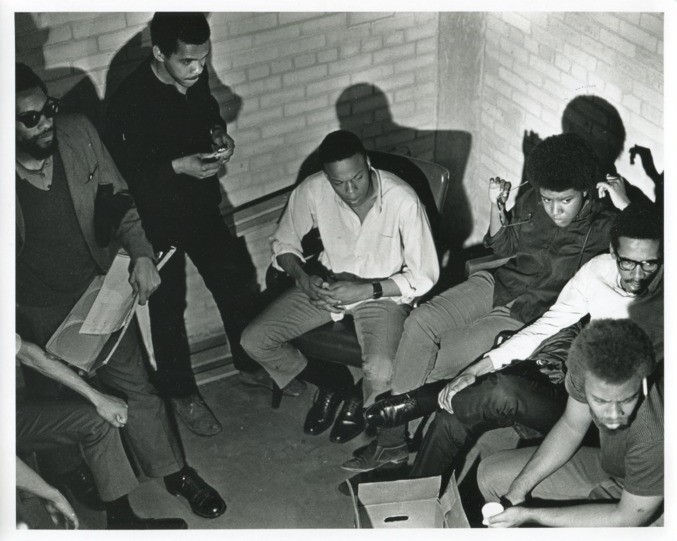SNCC Students Organizing (1960s)
Dublin Core
Title
Description
This photo portrays an organization meeting. All of the subjects in the picture are visually engaged with something or someone outside of the frame. It is impossible to tell what they are looking at. Their disengagement with the photographer suggests that it is a documentary photo instead of a staged group portrait. Student Organizations, like the Student Non-Violent Coordinating Committee (SNCC), hired professional photographers to document the movement. These photographs were then mass-produced and distributed around the country (Cox 31). SNCC was the most progressive in media outreach at that time. Danny Lyon was one of the first full time photographers hired by SNCC. His message: “to the world watching, SNNC, was faceless… my photographs were used to help create a public image” (Cox 30).
There are six men and one woman positioned in a semicircle around the photographer. Two men are standing and leaning against the wall while the other five figures are seated. The high vantage point at which the photo was taken gives the viewer an aerial perspective view of the meeting. The lighting in the room creates an intimate, secretive, and serious setting. It is obvious that the meeting taking place has the full attention of its participants.
SNCC used hired photographers to document a distinct point of view. According to Juilian Cox, by the end of World War II photos comprised one third of the total news space. SNCC leaders Diane Nash, James Bevel, and John Lewis recognized the opportunity that modern mass communication would provide (Cox 20). When SNCC hired photographers to document the movement they encouraged photojournalists to blend into the movement and become part of the effort. Photojournalists working for SNNC documented the direct action programs going on in the community and the behind-the-scenes work of orchestrating public demonstrations.
This generic photo of students meeting represents every single volunteer that gave their time to the movement. This snapshot of students organizing in the Civil Rights Movement is representative of all of the participating organizations because of the collective identity among student activists.
Until SNNC hired contract photographers a large majority of the movement outside of public demonstrations, protests, and direct action programs went undocumented (Cox 30). Photographers like Danny Lyon created public images. The photograph compositionally places the viewer within its intimate setting, thus making the viewer a part of the movement.
